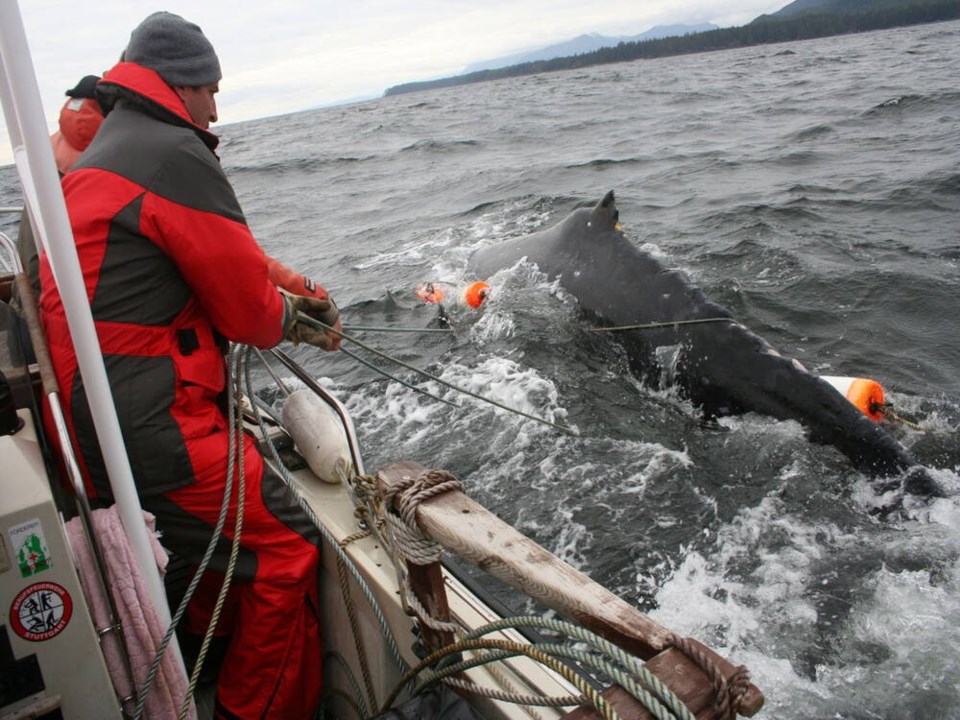Authorities are on the lookout for an entangled humpback whale most recently spotted off the north Island.
The whale, which is entangled in floats, was first reported on July 22 off Lennard Lighthouse near Tofino. It was spotted twice more the next day, but by the time specialists arrived, the whale couldn’t be found, said Karyssa Arnett, executive director of Strawberry Isle Marine Research Society.
Fisheries and Oceans Canada spokesman Dan Bate said the whale has since moved north, with a sighting off Quatsino Sound reported to the department’s mammal-incident hotline on Sunday.
Arnett, who has been out searching with DFO representatives, says humpback whales are more prone to entanglements and vessel strikes because of their “really sporadic moving behaviour.”
“They might pop up one place and then they might come up at a completely different spot the next time you see them, so that’s what makes them hard to track while you’re watching them.”
Strawberry Isle Marine Research, Parks Canada and fisheries officers in the Tofino region are trained to respond to whale entanglements by placing a satellite tracker on the gear attached to the whale, but only DFO has a specialized and trained unit to remove the entanglement.
Fishers, private boaters and whale-watchers are asked to keep a lookout for the whale. Anyone who spots it should call the marine mammal incident reporting hotline at VHF 16 or 1-800-465-4336 as soon as possible, keeping eyes on the whale — while staying 200 metres away — until other boats arrive, Arnett said.
“Hopefully, in the coming days, it is resighted and we can get back out there with equipment once again, and hopefully disentangle it,” said Arnett. “It takes a lot of effort and takes a lot of eyes to keep track of these things.”
Arnett said people should not attempt to disentangle the whale, which could be dangerous for those involved and harm the humpback.
The whale is towing two floats — one orange and one white. Arnett said that it’s assumed the lines are tangled around the tail but the equipment could also be attached elsewhere.
“There might be some more not-visible rope, maybe entangled around the pectoral flippers or through the mouth or something, too,” she said. “That’s why it’s really important for the professionals to go out there with the proper equipment and training.”
Entangled whales often have difficulty feeding and can starve to death. “Either the float or the entanglement is slowing them down, making it harder to dive and feed,” Arnett said.
Humpback whales migrate along the west coast on their way between Alaska and Hawaii, Mexico and Costa Rica.
“They’re primarily just trying to feed while they’re coming up the coast.”
Arnett said the number of humpback whales migrating past the Tofino area is in the thousands, and continues to grow.
“They’re actually coming on quite a big population rebound,” she said. “In the early days, they were hunted through whaling.”
Humpback populations were reduced worldwide by as much as 95 per cent until a final moratorium on harvesting the species for meat and oil was introduced in 1985 by the International Whaling Commission.
Humpbacks have been protected in Canada since 1966.
— With a file from the Times Colonist
Alexandra Mehl is a Local Journalism Initiative reporter with Ha-Shilth-Sa. The Local Journalism Initiative is funded by the Government of Canada.





